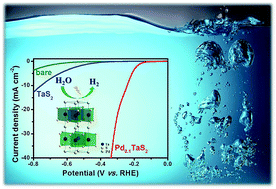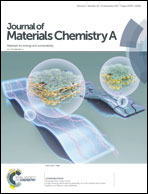Atom-scale dispersed palladium in a conductive Pd0.1TaS2 lattice with a unique electronic structure for efficient hydrogen evolution†
Abstract
Noble metal catalysts have extraordinary catalytic activity but suffer from high cost; therefore single atom catalysis attracts tremendous attention. Here, we propose atom-scale dispersed palladium (Pd) in a layered TaS2 lattice to form new compounds of PdxTaS2, whose crystal structure was resolved by powder X-ray diffraction. The electrical conductivity of metallic Pd0.1TaS2 (1.36 × 104 S m−1) is twice as large as that of TaS2 (6.18 × 103 S m−1). This compound applied as a new electrocatalyst for the hydrogen evolution reaction (HER) exhibits excellent catalytic performance with an onset overpotential of 77 mV, superior to those of other catalysts such as TaS2 (295 mV) and Pd-loaded TaS2 (114 mV). Density functional theory calculations reveal that the interaction of Pd-4d and Ta-5d orbitals results in the upshift of the Fermi level (TaS2versus Pd0.1TaS2) to decrease the barrier height for the HER. Furthermore, the hybridization of Pd-4d and S-3p orbitals builds up pathways along the c axis to improve the conductivity and promote HER performance. It is noted that the amount of Pd used in Pd0.1TaS2 is only 4 wt%, compared with 20 wt% in commercial Pd/C catalysts, which is beneficial for its practical application.



 Please wait while we load your content...
Please wait while we load your content...